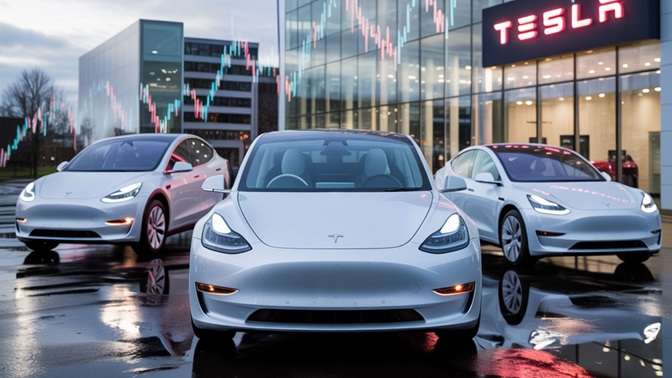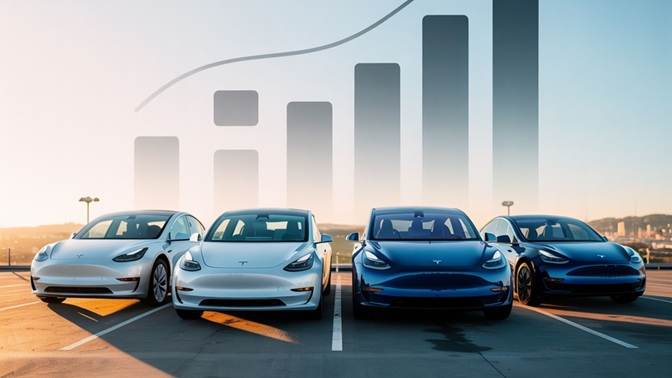Tesla status as the undisputed leader of American EVs is no longer a given. New data from Cox Automotive shows Tesla’s U.S. electric‑vehicle market share slipping to roughly 38%—its first dip below the 40% line in years. That’s a big psychological threshold for a brand that once commanded more than 80% of the domestic EV market and stayed north of 50% for a surprisingly long run.

The kicker? This is happening while U.S. EV sales are surging. With the federal $7,500 credit winding down, shoppers are rushing to buy sooner—a wave that should, in theory, lift all boats. Instead, it’s lifting more boats that aren’t Tesla.
Key takeaways
- Tesla’s U.S. market share fell to about 38%, down from the 50%+ range that held for years.
- Global deliveries are under pressure; declines versus the prior year are reported in both Europe and China.
- The wider U.S. EV market is booming as buyers move to capture remaining tax incentives—but rivals are taking a bigger slice.
- Analysts expect a demand “pull forward” before incentives fade, with a potential cooldown afterwards.
- Root causes: aging lineup, ferocious competition, and brand‑perception challenges—while the overall market grows.
Tesla’s share didn’t nosedive overnight; it eroded step by step as more credible EVs hit the road. Here’s a simplified view based on Cox Automotive’s recent snapshots:
| Period snapshot | Estimated Tesla U.S. EV share |
|---|---|
| Historic peak (context) | 80%+ |
| Long-running average (context) | 50%+ |
| Mid‑year checkpoint | 48.7% |
| Next checkpoint | 42% |
| Latest reading | ~38% |
American shoppers still buy a lot of Teslas, but the company’s worldwide momentum has softened compared with its peak:
- Europe: Tesla registrations are down sharply versus the prior year, with a decline reported around 40% in recent tracking.
- China: The world’s largest EV market shows a smaller, but still meaningful drop for Tesla, around the mid‑single digits.
- Global: Compared with its high‑water mark, the company’s worldwide deliveries are running lower than the prior year, with a steeper slide this year than last.

Ironically, the U.S. market is booming right now. With the federal purchase incentive phasing out, shoppers are pulling the trigger. Most automakers selling EVs are trying to capture that wave. The result: a much larger pie with more slices going to legacy brands (Ford, GM), tech‑savvy fast movers (Hyundai, Kia), and fresh entrants. Tesla’s slice, by comparison, is getting smaller.
- More (and better) choices: The number of legitimate EV contenders has exploded. Mainstream shoppers can now find attractive pricing, solid range, fast charging, and comfortable interiors without defaulting to a Tesla.
- Aging lineup, slower refresh cadence: Outside of running updates, Tesla’s core lineup hasn’t seen the steady drumbeat of all‑new models rivals are using to court buyers. A broader range—especially in the SUV/crossover sweet spot—would help.
- Price wars and margin pressure: Price cuts can defend volume for a while, but they also invite competitors to respond. Not every sale will go to the lowest price once features and dealership support are comparable.
- Brand and perception headwinds: For some buyers, CEO noise is part of the Tesla story—for others, it’s a turnoff. Regardless of where you land, rival brands have been quietly winning over shoppers with less baggage and robust marketing.
- Incentive timing: The incentive “pull forward” helps manufacturers who have fresh inventory and dealer networks ready to capture walk‑in demand. Tesla’s direct model offers strengths, but rivals now have very efficient dealer pipelines.
Because demand is being pulled forward ahead of the credit’s phase‑out, Tesla could still post a strong quarter in the U.S.—and will likely celebrate it. But that would be more about timing and incentives than a pivot in the underlying trend. After the incentive wave breaks, the real scoreboard will be visible again: product cadence, pricing power, brand pull, and software/value add.
- Refresh and expand the lineup: A truly new, lower‑cost platform and fresher SUVs/crossovers would meet the market where it’s growing fastest.
- Sharpen the value stack: Make ownership irresistible—home‑charging bundles, competitive financing, transparent delivery timelines, and stronger trade‑in options.
- Double down on real‑world software wins: If autonomy or advanced driver assistance is the future, prove it with measurable safety and convenience data, plus clearer road maps.
- Communicate like a leader: Keep the vision bold but the promises grounded. Buyers reward confidence, not overreach.
- Focus on durability and customer care: The more EVs the world buys, the more service support matters. A repeatable, low‑friction service experience builds lifetime loyalty.
What EV shoppers should do right now
- If you’re chasing the $7,500 incentive, move quickly and get pre‑approved. Inventory and delivery timing matter.
- Cross‑shop widely. Today’s EV market offers real choice at many price points and body styles.
- Consider total cost of ownership: energy costs, home charging, maintenance, insurance, and resale value.
- Test‑drive the tech: Screens, driver‑assist features, and charging experiences vary widely. Don’t assume they’re all the same.
Tesla’s early dominance forced the entire industry to move faster on EVs. Now that nearly every automaker has credible electric models, the “default EV” era is over. Competition is doing exactly what it should: bringing better vehicles to market, faster. That’s good for consumers—and it pushes every brand, Tesla included, to keep improving.
- Tesla’s U.S. share of the EV pie hit a new low, even as the pie got bigger.
- The company remains a top seller, but the “automatic win” phase is gone; it now needs to compete head‑to‑head on product, price, and customer experience like everyone else.
- A short‑term bump from incentive timing won’t change the long‑term scorecard. The next chapter will be written by fresh models, tangible software advantages, and everyday ownership experience.
If you’re an EV shopper, this is one of the best times—ever—to kick the tires. If you’re a Tesla fan, think of this moment as healthy pressure. The company thrives when it’s challenged. If it responds with great products and real value, everyone wins: more EVs on the road, better tech in our driveways, and a faster transition to cleaner transportation—without sacrificing the fun stuff that gets us behind the wheel.
Related Post
